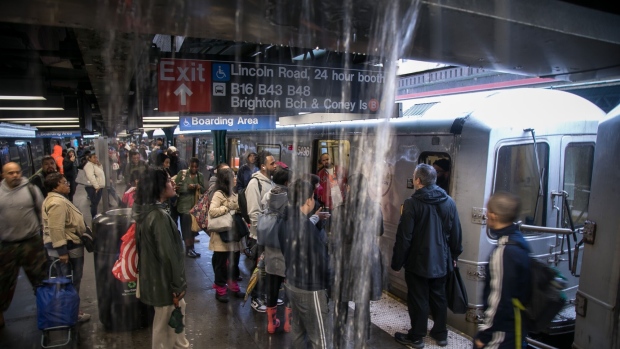Apr 25, 2024
New York City Needs $6 Billion to Protect Subway System in Harsh Weather
, Bloomberg News

(Bloomberg) -- New York City’s transit system plans to spend $6 billion during the next few years to make its subway stations and commuter rail lines more resilient to extreme weather events that have pummeled the network and caused service shutdowns.
The Metropolitan Transportation Authority, which operates the city’s subways, buses and commuter rail roads, needs those funds to prevent station and track flooding and protect infrastructure from rising temperatures, MTA officials said Thursday at a press conference announcing the transit agency’s climate resilience roadmap. The plan is the MTA’s blueprint of how it will strengthen its infrastructure against climate change.
“For New Yorkers, transit is like air and water, we need it to survive,” Janno Lieber, the MTA’s chief executive officer, said during the conference. “And it will not survive unless we plan to protect the system from climate change.”
Heavy rainfalls and hurricanes have damaged MTA infrastructure and prevented subways and trains from operating smoothly. YouTube videos show water cascading into subway stations during rain storms late last year. MTA officials anticipate coastal surges, torrential rains and incidences of extreme heat to increase between now and the 2050s.
While the MTA in recent years has installed flood doors and walls, elevated electrical equipment and increased coordination with the city’s Department of Environmental Protection to clean out catch basins and sewer siphons, the system still has vulnerabilities. About 41% of train tracks on Metro-North Railroad’s Hudson line run next to steep slopes, creating mudslide risks, Jamie Torres-Springer, head of the MTA’s construction and development, said during the event. And one-sixth of that line’s tracks will be covered in water during monthly high tides by the 2050s. About 63% of the city’s subway system runs underground, making it vulnerable to heavy rainfall.
“If we don’t take the proper precautions, we’ll end up with more disruptions from extreme weather events and with deteriorating service levels, even on sunny days due to the deterioration of our infrastructure,” Torres-Springer said.
Planned renovations include raising street vents, elevating street stairs at entrances to subway stations, upgrading subway drainage equipment, expanding subway yard drainage systems, and stabilizing steep slopes along the Hudson line according to the roadmap.
The expected $6 billion cost will be included in the MTA’s next multi-year capital budget, which the agency will release later this year. MTA and state lawmakers have yet to detail how that spending plan will be funded.
(Updates with details on the system’s vulnerabilities in the fifth paragraph.)
©2024 Bloomberg L.P.






